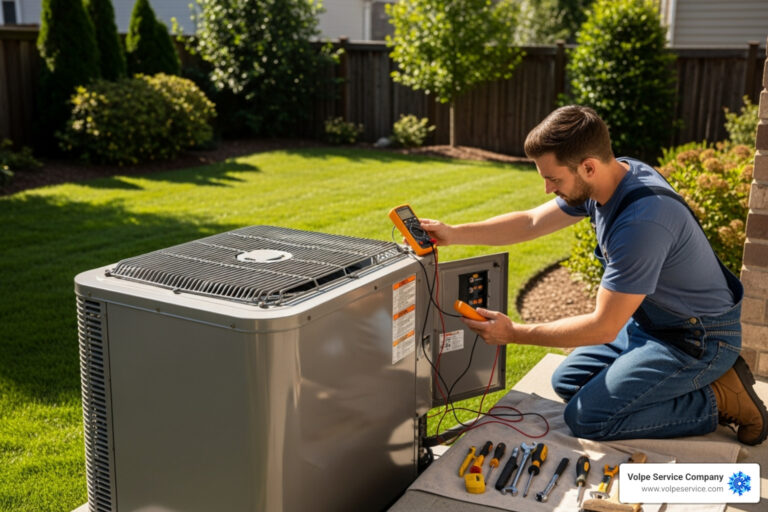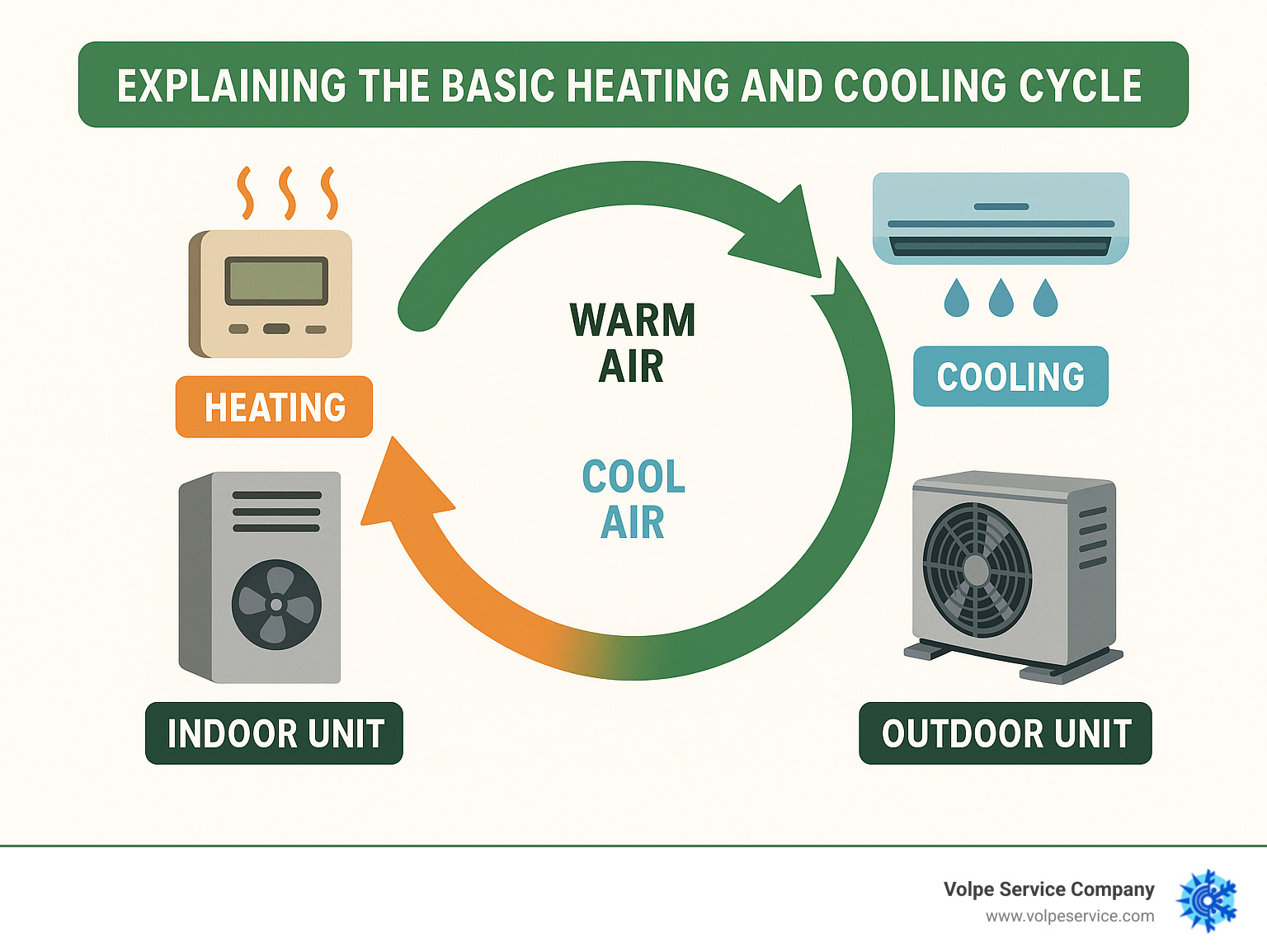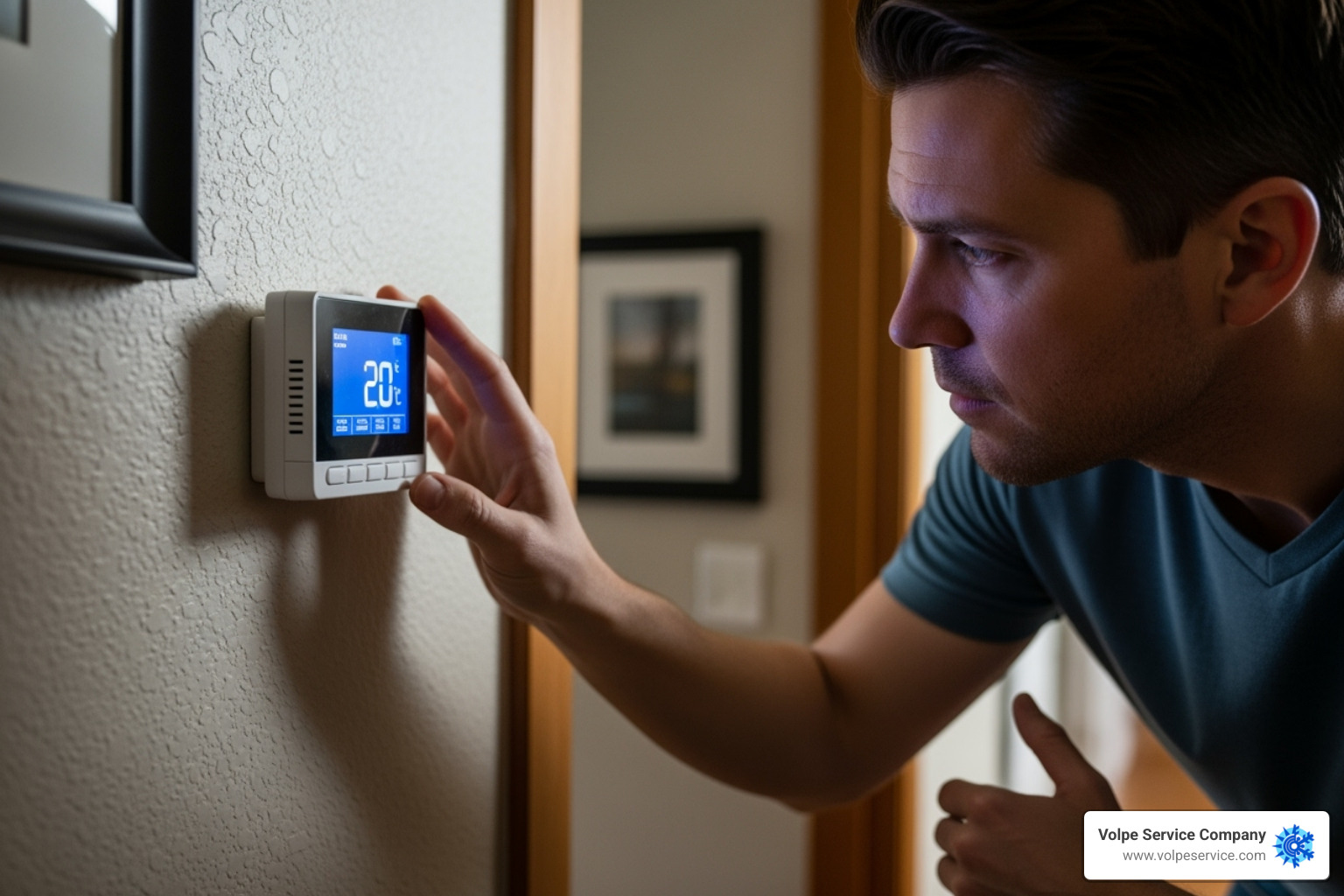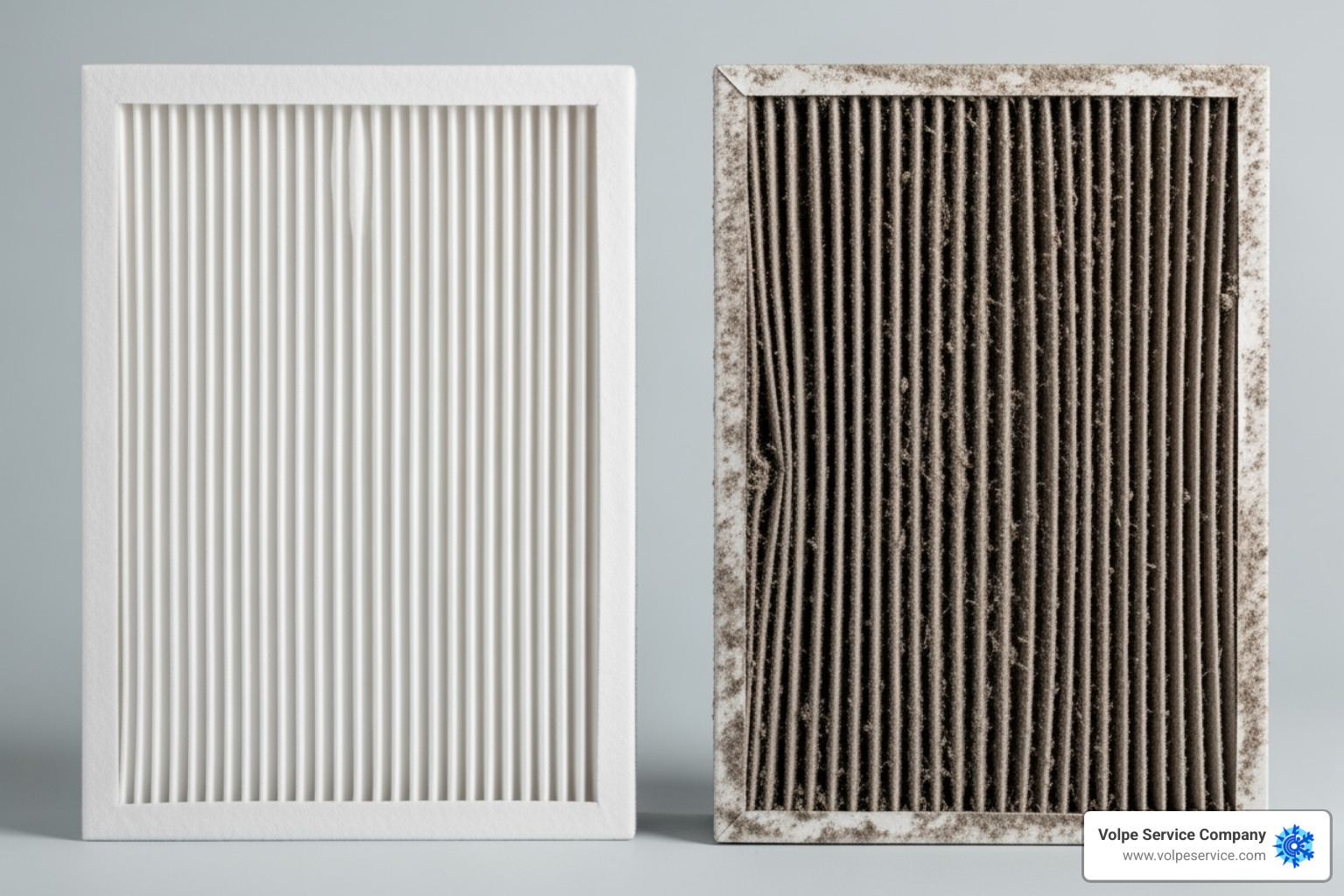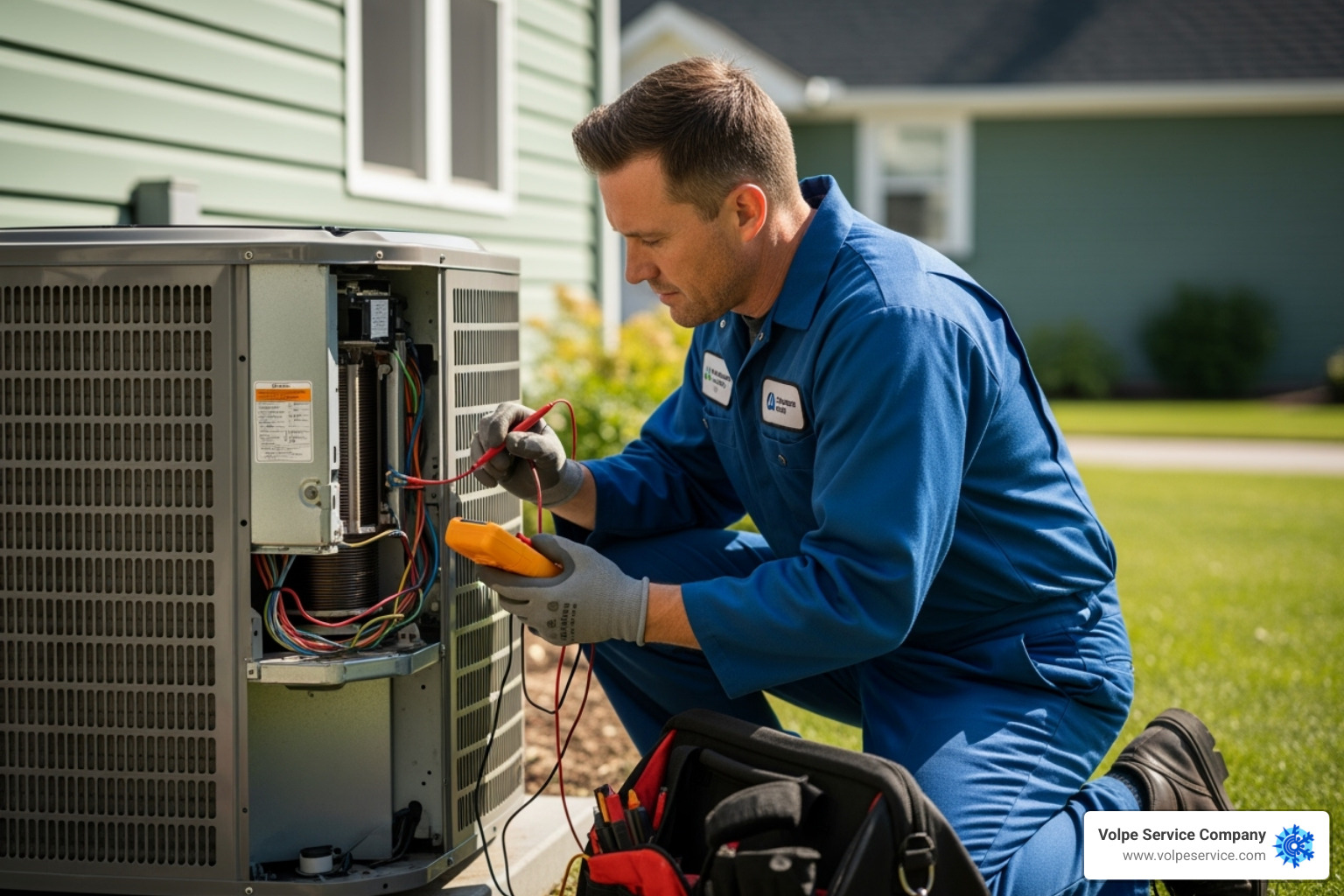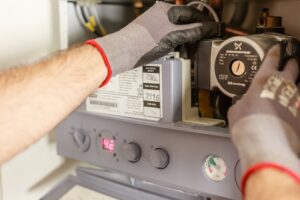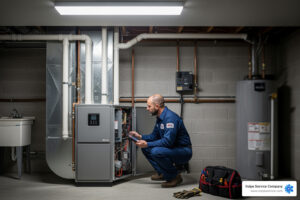Why HVAC System Troubleshooting Skills Can Save You Time and Money
HVAC system troubleshooting is a valuable skill for any homeowner. When your system acts up, basic troubleshooting can often restore comfort quickly or clarify when to call a professional.
Quick HVAC Troubleshooting Checklist:
- Check thermostat settings – Ensure it’s set to heat/cool and the temperature is correct.
- Inspect circuit breakers – Look for tripped breakers and reset if needed.
- Replace dirty air filters – Clogged filters cause most HVAC problems.
- Clear blocked vents – Remove anything blocking airflow.
- Check outdoor unit – Clear debris from around the condenser.
- Listen for unusual noises – Grinding or squealing sounds need professional attention.
Many HVAC problems have simple solutions. Checking basics like power switches and dirty filters can resolve common issues without professional help.
However, it’s crucial to know what you can safely fix versus what needs a trained technician. Some issues require specialized tools, electrical knowledge, or handling refrigerants, which only licensed professionals should tackle.
This guide will walk you through troubleshooting common problems like a system that won’t turn on, poor airflow, strange noises, or uneven temperatures, helping you decide between a DIY fix and a professional call.
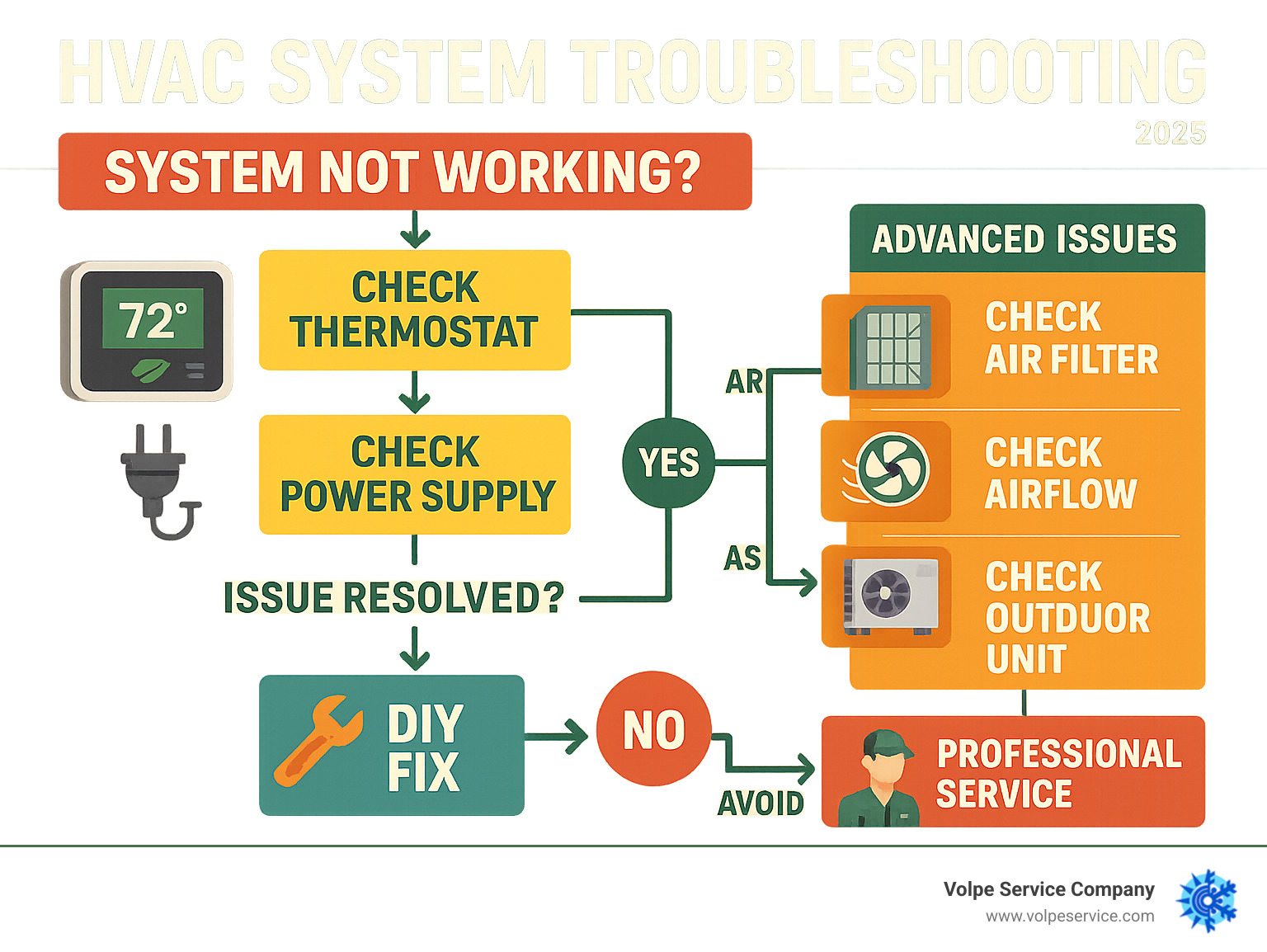
Your HVAC System: A Quick Primer
Before troubleshooting, let’s understand your HVAC system. It might seem complex, but its main job is simple: keeping your home comfortable.
HVAC (Heating, Ventilation, and Air Conditioning) is your home’s climate control. When it works, you don’t notice it. When it fails, troubleshooting knowledge is essential.
Key components include a furnace (heating), air conditioner (cooling), or a heat pump (both). Ductwork distributes air through vents, and the thermostat acts as the control center.
For heating, a furnace warms air that a blower pushes through ducts. For cooling, an air conditioner uses refrigerant to remove heat from indoor air before circulating the cool air back into your home.
Understanding Your System’s Core Components
Knowing your system’s main parts simplifies HVAC system troubleshooting. You’ll have a better idea of where to look when something goes wrong.
Your indoor unit, usually in a basement, attic, or closet, contains the furnace or air handler. This houses the blower motor for air circulation and the evaporator coils for cooling.
Outside, the outdoor unit is your air conditioner or heat pump condenser. It contains the compressor and condenser coils. The compressor moves refrigerant, and the coils release heat outside during cooling.
Refrigerant lines connect the indoor and outdoor units, transporting heat from inside your home to the outside.
Understanding these parts helps you communicate better with technicians and gives you confidence to tackle basic issues. For more on cooling problems, check out what are the most common air conditioner problems.
The Crucial Role of the Thermostat
Your thermostat is often the source of HVAC problems. As the control center, if it’s not working correctly, the entire system can fail.
Programmable thermostats let you set schedules to save energy, while smart thermostats learn your habits and allow remote control via your phone.
For troubleshooting, ensure temperature settings are correct: set higher than the room temperature for heat and lower for cooling. This simple check often solves the issue.
Check the fan settings. Auto runs the fan only during heating/cooling cycles, saving energy. On runs the fan continuously, which improves circulation but uses more power.
Battery issues are also common. If the thermostat display is blank or erratic, try replacing the batteries before calling for service. This simple fix can prevent an unnecessary service call.
Your Step-by-Step Guide to HVAC System Troubleshooting
With a basic understanding of your system, let’s tackle some real-world HVAC system troubleshooting. Many seemingly serious problems have simple solutions. We’ll start with the most frequent issues.
HVAC First Aid: System Won’t Turn On
If your system won’t turn on, don’t panic. These quick checks often solve the problem without a service call.
First, check your thermostat. Ensure it’s in the correct mode (heat/cool) and the temperature is set appropriately. A blank display often means dead batteries.
Next, check the power supply. Look for tripped circuit breakers in your electrical panel. Most systems have two: one for the indoor unit and one for the outdoor unit. To reset a breaker, flip it fully to “off,” wait ten seconds, then back to “on.” If it trips again, there’s a larger electrical issue requiring a professional.
Older systems may have fuses. A blown fuse has a visible broken wire. Turn off the main power before replacing it with an identical fuse.
Check the emergency shutoff switch near the indoor unit; it can be bumped accidentally. Also, ensure the furnace access door is closed tightly to engage the safety switch.
As a last resort, perform a system reset. Turn the main breaker off for 30 seconds, then back on to clear electronic glitches.
Basic HVAC system troubleshooting for airflow problems
Weak airflow makes your home uncomfortable and forces your system to work harder. The cause is often a simple fix.
A dirty air filter is the most common cause of airflow problems. A clogged filter restricts air, forcing your system to overwork and potentially overheat or shut down.
Replace your filter every 1-3 months (more often with pets or allergies). It’s a cheap way to maintain system health.
Blocked vents are another common problem. Check that furniture, rugs, or toys aren’t obstructing supply and return vents. Ensure all vent louvers are fully open.
The outdoor unit also needs space. Clear away leaves, grass, or bushes, ensuring at least two feet of clearance on all sides. Turn off the power before cleaning it with a hose.
Inspect visible ductwork in your basement or attic for tears, disconnected joints, or damage. Note any issues for a professional to repair.
What to Do About Water Leaks or Icing
Seeing water near your unit is a red flag, but it often has a simple cause.
A clogged condensate drain line is a frequent issue. Your AC removes humidity from the air, and the drain line for this water can get clogged with algae or debris. If water is pooling near your indoor unit, a blocked drain is likely. Try clearing it by pouring a cup of white vinegar down the access point, letting it sit for 30 minutes, then flushing with water.
Ice on your indoor coils indicates an airflow problem, often caused by a dirty filter. Poor airflow causes the coil to get too cold, leading to ice buildup, which further restricts airflow. If you see ice, turn off the AC and set the fan to “On” to melt it. Don’t scrape the ice off. After it thaws, replace the air filter. If ice returns, you may have a refrigerant leak needing professional service.
Safety First: Always turn off power at the circuit breaker before investigating water leaks. Water and electricity are a dangerous mix.
Diagnosing Common HVAC Issues
Your HVAC system often signals problems through specific sounds or behaviors. Understanding these signs is a key part of HVAC system troubleshooting and helps you know when to call a professional.
Why Is My HVAC System Making Strange Noises?
Don’t ignore strange HVAC noises. They are warning signs that can help you prevent larger issues.
- Rattling or banging often means a loose part or debris. Check for loose panels or debris in the outdoor unit. A loud bang from a furnace could be delayed ignition, which requires a professional.
- Squealing or screeching usually indicates a worn belt or failing motor bearings in the blower or outdoor fan. Address this sound quickly to avoid more expensive repairs.
- Grinding is a serious sound that almost always points to failing motor bearings. This requires immediate attention.
- Hissing or gurgling can signal different issues. Hissing often indicates a refrigerant leak, especially with poor cooling. Gurgling can mean air in the refrigerant lines or a backed-up condensate drain.
- Clicking is normal at startup, but persistent clicking can indicate a failing electrical relay, ignitor, or control board issue.
Why Is My HVAC System Running Constantly?
A constantly running system increases energy bills and component wear. Fortunately, the cause is often a simple fix.
- Thermostat settings: Check if the fan is set to “On” instead of “Auto.” Also, ensure the temperature setting is realistic for the outdoor conditions.
- Dirty air filter: A clogged filter restricts airflow, forcing the system to run longer to reach the target temperature. Replacing it is a common and easy fix.
- Refrigerant leaks: These cause the AC to run constantly with poor cooling results. Signs include ice on the outdoor unit or hissing sounds.
- System sizing: An undersized unit will run constantly to keep up, while an oversized one may cycle too frequently, leading to poor performance.
- Leaky ductwork: This allows conditioned air to escape, making your system run longer to compensate for the loss.
How to Fix Uneven Heating or Cooling
If some rooms are comfortable while others aren’t, several factors could be the cause.
- Ductwork issues: Leaks, blockages, or damage can prevent conditioned air from reaching certain rooms. Check accessible ducts for obvious problems.
- Blocked vents: Furniture or rugs covering registers can cause uneven temperatures. Avoid closing vents in unused rooms, as this can disrupt system balance and reduce efficiency.
- Insulation problems: Poor insulation in walls, attics, or around windows makes it hard for your HVAC system to maintain even temperatures. Check for drafts to identify problem areas.
- Balancing dampers: These dampers in your ductwork can be adjusted to control airflow to different zones. This is often best left to a professional to ensure proper system balance.
- HVAC zoning: With a zoned system, a malfunctioning damper or control can cause issues in one area. This problem usually requires professional diagnosis.
When to Call a Professional
While basic HVAC system troubleshooting is useful, recognize your limits. Some repairs are dangerous and should not be attempted by homeowners.
Safety First: Know Your Limits
Your HVAC system is a complex machine with serious hazards. For your safety, leave the following issues to trained professionals.
- Electrical hazards: Your system uses high-voltage electricity that can be fatal. Beyond changing batteries or resetting a breaker, all electrical work should be left to a professional.
- Refrigerant handling: Handling refrigerant is illegal without certification and dangerous. It can cause chemical burns and respiratory issues and harms the environment.
- Gas furnace risks: With a gas furnace, a leak can cause fires or carbon monoxide poisoning. If you smell gas (a “rotten egg” odor), evacuate immediately and call your gas company.
- Complex mechanical parts: Components like compressors and heat exchangers require specialized tools and knowledge. DIY repairs on these parts are unsafe and often cause more damage.
- Voiding your warranty: Attempting DIY repairs can void your system’s warranty, as most manufacturers require service by licensed professionals.
Advanced HVAC system troubleshooting: When to call a professional
Recognizing red flags that require a professional can save you money and prevent a small issue from becoming a major one.
- Refrigerant leaks: If your AC blows warm air, runs constantly, or has ice on the outdoor unit, you likely have a refrigerant leak. This is not a DIY fix.
- Compressor failure: The compressor is the heart of your AC. Its failure is a major repair that always requires a professional.
- Electrical component failure: Failures of parts like capacitors, contactors, or control boards require professional expertise. Using the wrong replacement part can cause further damage.
- Persistent circuit breaker tripping: If a circuit breaker repeatedly trips, it signals a serious electrical fault that could be a fire hazard. Turn off the system and call a professional immediately.
- Burning smells or smoke: A burning smell (other than the initial dusty smell when a furnace starts for the season) is an emergency. Shut down the system and call for service immediately.
Preparing for Your Technician’s Visit
A little preparation before your technician arrives can lead to a faster, more accurate diagnosis.
- Note the symptoms: Describe the problem in detail: what noises is it making, when did it start, and is it constant or intermittent?
- Have model and serial numbers ready: You can find these on your indoor and outdoor units. This helps the technician prepare with the right parts and information.
- Clear access to units: Ensure there is clear access to both your indoor and outdoor units. Clearing the area saves time.
- Provide maintenance history: If you have repair records, share them. This context can help identify recurring problems.
When basic HVAC system troubleshooting fails, calling a professional is a smart decision that protects your safety, your system, and your wallet.
Frequently Asked Questions about HVAC Troubleshooting
As HVAC professionals in New Jersey since 1963, we’ve answered many questions. Here are the most common ones we hear about HVAC system troubleshooting.
How often should I change my HVAC air filter?
This is our most common question. We recommend changing your filter every 1 to 3 months, but the ideal frequency depends on your home.
Change it monthly if you have pets that shed or family members with allergies or asthma. A clean filter significantly improves indoor air quality. Homes with high foot traffic or nearby construction also require more frequent changes due to increased dust.
A good habit is to check your filter monthly. Hold it to a light; if you can’t see through it, it’s time for a replacement. This simple step prevents many common HVAC issues.
What are the most common HVAC problems homeowners can fix themselves?
Many common HVAC problems can be fixed by homeowners, saving time and money.
- System won’t turn on: Check the thermostat settings and batteries. Then, check for and reset any tripped circuit breakers.
- Weak airflow: This is usually caused by a dirty air filter. Replace the filter and ensure no vents are blocked by furniture or rugs.
- Poor heating or cooling: Check the air filter first. Then, clear any debris from around your outdoor unit, ensuring it has at least two feet of clearance.
- Minor water leaks: This may indicate a clogged condensate drain. You can try clearing it with a cup of white vinegar.
- Rattling noises: This often means a loose panel or debris. Check both indoor and outdoor units.
If these steps don’t work or the issue is electrical, it’s time to call a professional.
Is it normal for my outdoor unit to have ice on it in the winter?
This is a common winter question, and the answer depends on the amount of ice.
For a heat pump, a thin layer of ice is normal in cold weather. The unit has a defrost cycle that periodically melts this ice. During the defrost cycle (5-15 minutes), the fan will stop, and you may see steam. This is normal operation.
However, excessive ice buildup, where the entire unit is encased, indicates a problem. This can be caused by restricted airflow (like a dirty filter), low refrigerant, or a faulty defrost control.
If you have excessive ice, turn the system off to let it thaw. You can run the fan to speed it up. After it thaws, replace the air filter. If the ice returns, call a professional, as it could be a refrigerant leak or control issue. A little ice on your heat pump is normal in winter, but excessive ice is a sign it needs professional attention.
Your Partner in Home Comfort
This HVAC system troubleshooting guide has shown that many common issues have simple fixes, like checking a breaker, changing a filter, or adjusting the thermostat. These steps can save you time and money.
But here’s what we really want you to remember – knowing your limits is crucial. For safety, leave issues involving electricity, refrigerant, or gas lines to professionals. DIY repairs on complex systems can cause more damage and void your warranty.
The best way to avoid troubleshooting is with regular professional maintenance. Like car care, it prevents major breakdowns, improves efficiency, and extends your system’s lifespan.
At Volpe Service Company, we’ve been helping New Jersey families stay comfortable since 1963. As a family-owned business, we understand that your home is your sanctuary, and we’re committed to keeping it that way. Our approach is straightforward – we use data-driven solutions to diagnose problems accurately, we guarantee our service, and we believe in being honest and professional in everything we do.
Whether you’re in East Hanover, Parsippany, Mt Olive, or Chester, we’re your neighbors, and we’re here when you need us. When those HVAC system troubleshooting steps we’ve covered aren’t enough, or when you want the peace of mind that comes with professional maintenance, our experienced technicians are ready to help.


